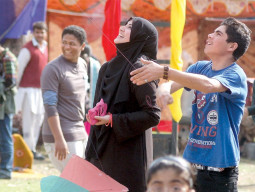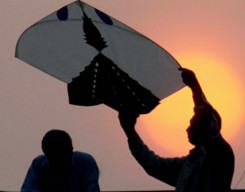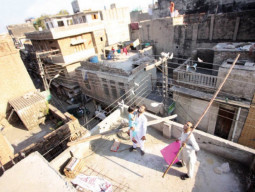
The Lahore skies are not full of kites — or at least not as full as they used to be before the 2005 Supreme Court ban on kite-flying. But is it wise to ban one of the few events which provide entertainment to our people despite the fact that deaths have occurred due to people falling off from roofs and glass-coated threads which have slit throats? Let us look at the history of this festival to find out what the truth is.
One objection to Basant is that it is un-Islamic. There are two reasons given for this. First, that it was a religious festival among Hindus and second, that it celebrates a blasphemer. Let us take them one by one. The word ‘vasanta’ means ‘green’ and’ panchami’ refers to ‘five’ in Sanskrit. This means that it was the fifth day of the month of Magh in the old calendar, which is not used officially in Pakistan but is very much part of the rural worldview. The festival is so ancient that it existed in the Vedic period and it did have a religious significance, as most life events did in the ancient world. It was dedicated to the Hindu goddess Saraswati, the goddess of learning. In time, however, this significance was lost and all communities, Hindus and Muslims, enjoyed it as a time of celebration. Likewise, the Nauroz (new day), now celebrated not only in Iran but also in Central Asia, originated from Zoroastrianism but is a spring festival now — a time of fun and celebration of the spring. Europe’s May Day festivals also date to pre-Christian times and had religious significance to do with belief systems before Christianity. But then, they were taken over and celebrated as secular festivals. These events are part of spring festivals all over the world. From the Kha b’Nisan festival of the Assyrian civilisation to the present-day Chinese spring festival, the Thai Songkran Water Festival and the festival of bonfires resurrected in Luxembourg on February 26, people like to celebrate the coming of life after the winter. Now, the second reason.
It may be true that a local Basant fair at Kot Khawaja Saeed (Khoje Shahi) was initiated by a prosperous Hindu called Kalu Ram, to remember Haqeeqat Rai Bakhmal Puri. Haqeeqat Rai was a Hindu from Sialkot, who had been given the death punishment by Zakaria Khan (1707-1759), the then governor of Punjab, on charges of blasphemy. But it is not true to say that Basant was not celebrated earlier nor is it true that Muslims had not celebrated it. Indeed, there is a lot of evidence that Basant was celebrated by ordinary Muslims in India and even some Chishti saints. The literature refers to the “Basants” of Khwaja Qutbuddin Bakhtiar Kaki (1173-1235) and Sheikh Nizamuddin Aulia (1238-1325). But the best known is the song attributed to Amir Khusrau’s (1253-1325) which goes like this:
Aj basant mana le, suhagan
Aj basant mana le.
(Today celebrate the Basant Oh! Married girl,
Today celebrate the Spring)
And this is not all. Reports on schools dating from 1852 quote the following lines in Persian:
Basant amad ke sabzan hamachu sad burg,
Kharaman kubaku jama zebe
(Basant has arrived and young boys like a hundred petals,
Strut about the streets in beautiful clothes).
In short, the festival of spring was very much a part of the Indian Muslim civilisation since the medieval age. There were ulema who were against it but then they were against all cultural activities and almost against anything smacking of fun and laughter. During the period of decline of Muslim political powers, such thinking gained strength because when a civilisation declines, people want to know why. And people like Shah Waliullah (1703-1762) said the decline was because of the adoption of Hindu customs. The fact is that most people had converted from Hinduism to Islam and whenever such conversions occur, parts of culture are retained. Nobody bothered about them too much when the Muslims were powerful but now these have become anathema.
The Supreme Court’s reasoning that people die can be dealt with by good governance. Open grounds can be reserved for flying kites and the police should check whether the killer thread is used or not. In short, Basant should be celebrated just as Nauroz and other spring festivals are. Let us reclaim our shared South Asian culture: the festive atmosphere, the skies full of colour, the good food, the girls in yellow dresses and bangles; and the triumphant cries of ‘bo kata’ (I have cut it!).
Published in The Express Tribune, March 12th, 2013.
COMMENTS (16)
Comments are moderated and generally will be posted if they are on-topic and not abusive.
For more information, please see our Comments FAQ


















1713272658-0/Copenhagen-fire-(1)1713272658-0-270x192.webp)


1713268762-0/Netflix-(3)1713268762-0-270x192.webp)























I agree with the idea of organizing the festival on huge open grounds where it can be monitored. Where people are not riding motorcycles, bicycles, open carts or trucks. Neither are kids running after falling kites on busy roads nor they are on the edge of roof & ledges. Celebrate anything but do a survey of players, public participants and local authorities of their willingness to follow guidelines or inforce them properly. Religion don't need to involve in every games or plays origin. Our religion also incorporated holidays of past practices if we look closely.
The ban on kite flying is the most rational, moral and logical action. Kite flying resulted in the deaths of many innocent children each season before it was banned. It is callousness of the highest degree to advocate for a recreational event which resulted in slitting the throats of many innocent children and adults travelling on two wheelers. The Kite flying advocates are mostly the people who don not travel on a cycle or motor cycle. Their lack of empathy and disregard for human life is more than those terrorists who are killing people in the name of religion. Fanatic terrorists though misguided kill in the name of religion but these kite lovers want to slit throats and spill blood of poor and innocent children and adults just for recreation. The cord used in kite flying is dangerous to human life to some degree in any case though metallic one is most dangerous. The irrational, hypocratic and illogical arguments in favour of kite flying are not based on reality and truth and are falsified by the news reports of deaths and injuries suffered by the children and adults by the killing Kite flying cord. Efforts were made before the ban to check the use of lethal cord but it proved an impossible task for the reason, inter alia, that the kite flying is mostly done on roof tops and police cannot control the use of cord without violating the privacy and dignity of home. Additionally, the dangerous cord takes life after it comes to the ground having been cut or broken (Bo Kata) far away from the kite flier. Consequently, it is not possible to apprehend the culprit. Accordingly, the premise, logic and rationale behind the ban is not religious but human.
You have completely confused the whole thing just like all those people who have no idea of kite-flying. I am 100 percent sure that you have never been a kite-flyer. Ask any avid kite-flyer and you will find out that the religious mumbo-jumbo that you have attached to the banning of Basant was never a problem. The deaths caused by the loose strings was the problem and that too not because of glass-coated strings (sigh you have no idea of kite-flying). Glass coated strings have been there since eternity. The root problem was the tensile strength of the string which increased exponentially over the years. At the end Pakistani people themselves are responsible for this ban because they wanted unbreakable strings. I remember the strings from my childhood, they used to break when they got tangled up in someone's neck.
@Shamy, @kaalchakra, etc
Can I just remind you that Dr. Tariq Rahman Sb is an HEC Distinguished National Professor for life, and has served as professor emeritus and chair at Universities between here and California, Berkeley. He has more knowledge of the history and culture of Pakistan that you or I will ever have so please, SHOW SOME RESPECT. I know your narrow versions of Islam teach you that there is only one book worth reading, but trust me, if you broaden your horizons and your reading vocabulary you might learn something. Police can crack down on illegal manjha the way they have implemented a dozen other laws - bans on sheesha in Sindh, for example. Or bans on weddings carrying on after 10pm. Or bans on restaurants staying open in Ramzan. Everything is possible if there is will. Stop trying to be more Arab than the Arabs. Or migrate to UAE and leave the rest of us bad, fun loving Muslims alone PLEASE!
The writer seems to be too fond of kite-flying (of all kinds) to be pragmatic. Dangerous!
@Anwar: great satire brother!
@NJ "Basant was also celebrated by Muslims!" What Muslims did was wrong. They should have not celebrated it because it was invented by Hindus. Do Muslims celebrate Christmas and give presents ? NO.
This is why Christians have been losing the battle with atheism. They are too weak unlike Muslims because Muslims are like a wall of rock and will not compromise and why Muslims are so strong. We need to become mainstream Muslims and better Muslims.We have been living in jahiliyya for hundreds of years Look at the faith of the Arabs look at us. Look at their purity and our mixed up sufi and hindu mess.
To those self-styled defenders of our faith and traditions; to the zealous guardians of children lost only to kite-string: what of your cornflakes, toast and tea for breakfast — there’s no religion or local culture in that; what of the others? By defenestrating Basant from Lahore, you have only taken the colour from your own life.-Ahmed Rafay Alam exactly. Your tea, toast, jam, butter is is also not mainstream Mulsim islamic food. please go ahead and stop using internet and reading articles online. All this is not Islam. Its western inverntions that we muslims freely use!
@Anwar, Basant was also celebrated by Muslims! I hope your faith isnt so weak that flying kites pose a threat to it!!! Its a festival. Enjoy it or sit at home if you feel so threatened! Lahoris who have been celebrating it for hundreds of year want it back!
No he is saying celebrate it in open grounds!!!!!! Have basant only for a weekend!! Yes if its celebrated in grounds, threads can be checked!! It is managable, if only one wants to! And we want Basant Back!!! Its our tradition!!! Please stop eating breathing and laughing because thats exactly what our Hindu ancestors also did!! Please talk sense! No religion can be threatened by flying kites!!!!! It was always a Lahori thing! No city in India or Pakistan can celebrate Basant like Lahore does! We want BASANT BACK!
Basant has been celebrated in Lahore for hundreds of years!!! Flying kites and enjoying a festival is NO threat to any religion! The festival brought employment to thousands of people who sold kites, thread, food and so many other things. It was a happy festival in which every Lahori could participate. Everyone can afford a kite and have an amazing beautiful day! Banning it to appease mullahs is ridiculous! We Want Basant Back!
So the Basant was banned because "people were dying" and Mr Writer's 90% article is about how it is not un-islamic to celebrate basant. Bhaijan please.
Apparently, our police couldnt detect/stop trucks filled with 1000Kg of explosives, passing by many checkposts and blowing up people in pieces, every other day and Doctor Sahab's solution is that police should check millions of rooftops around the country to see whoz using killer thread.. I mean seriously??
Basant and Nauroz are not for us. We are no longer Hindus or Fire worshippers. We need to move inline with mainstream muslim traditions..
Lot more People die in celebrating muharram, should it be banned as well?
with basant, if you are not doing pooja of any god or goddess then it is not religious. just like going to malls during christmas is not christian.
its a fun event, celebrate it good friends. At least it doesnt have terrorist threats, the ugly part of accidental deaths can be dealt with laws and regulations.
I had always opposed this 'festival' as wasteful, dangerous, and improper. Now that we know it was started by a blasphemer who was rightly killed, I am most certainly not going to celebrate it.
"the police should check whether the killer thread is used or not" - are you for real ?